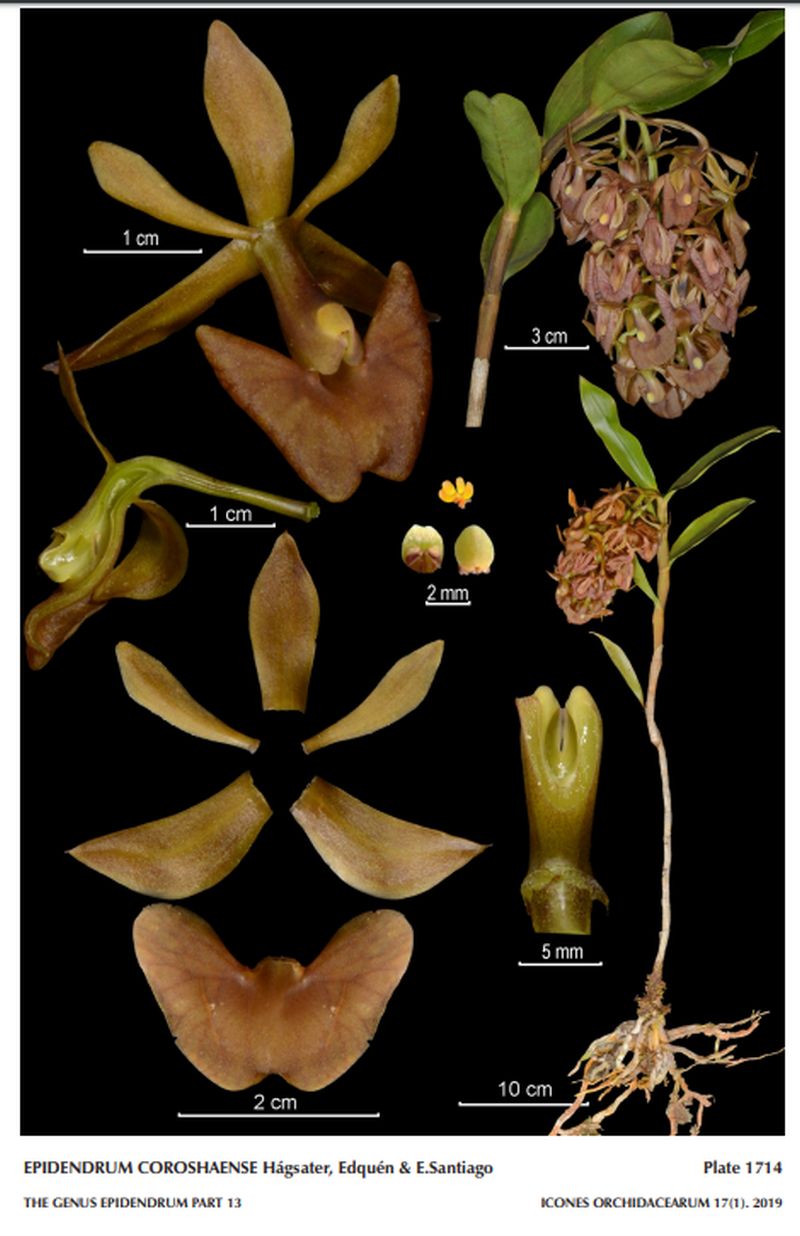

Epidendrum coroshaense Hágsater, Edquén et E.Santiago 2019 GROUP Arbusculum SUBGROUP Incomptum
LCDP Photo by © E. Hágsater & A. Cisneros/TYPE Photo by © Eric Hagsaster and AMO Herbaria Website

 EARLIER
EARLIER
Common Name The Corosha Epidendrum [A town in Amazonas department of Peru near where the orchid was discovered]
Flower Size .4" [1 cm]
Found in Amazonas Department of Peru, on the eastern slope of the Andes, on isolated trees in pastures of two sites [37 miles [56 km] distant, separated by a small mountain range, in the upper reaches of the Utcubamba river basin, a branch of the Marañón river, at elevations of 2015 to 2475 meters as a mrdium sized, cold growing epiphyte with erect, simple, cane-like, thick, terete, the new stem arising from a middle internode of the previous stem; lower part covered by non-foliar sheaths brown, turning pale gray carrying 3 to 5, aggregate towards the apex of the stems, distichous, base embracing the stem, sub-coriaceous; sheaths tubular, minutely striated, greenish brown; blade elliptic, obtuse, green, concolor, margin entire, spreading leaves taht blooms in the earlier fall on a terminal, without a spathe, peduncle .4" [1.0 cm] long, terete, yellowish green; rachis 3.6" [9 cm] long, totally hidden by the flowers, 5.2" [13 cm] long overall, apical, racemose to paniculate (sometimes producing a short branch from the base of the peduncle), arching-nutant, densely simultaneously 6 to 25 flowered inflorescence with shorter than the ovary, narrowly triangular, acuminate, embracing floral bracts and carrying resupinate, fleshy, reddish brown flowers with the column green when young, turning reddish brown with age, the anther yellowish green and no fragrance.
"Epidendrum coroshaense belongs to the GROUP Arbusculum SUBGROUP Incomptum which is characterized by having erect successive lateral growths produced from the middle of the previous growth, few leaves aggregate towards the apex of the stems, a short apical inflorescence with fleshy green to violet-green flowers with short ovaries, and the lip entire to 3-lobed. The new species is recognized by the densely flowered inflorescence with reddish-brown flowers, petals .64 to .72" x .12 to .18" [16 to 18 x 3.0 to 4.5 mm], oblanceolate, sepals .68 to .8" [17 to 20 mm] long, falcate, lip .68 to .76" x 1.08 to 1.12" [17 to 19 x 27 to 28 mm}, reniform with large, retrorse, divaricate, transversely obovate, rounded lobes. Epidendrum subreniforme C.Schweinf. from Huánuco has smaller leaves, 1.84 x .6" [4.6 x 1.5 cm], greenish yellow flowers, petals .74 x .14" [18.5 x 3.5 mm], linear-oblanceolate, sepals .86 x .36" [21.5 x 9 mm], and a reniform lip .48 x 1,32"[12 x 25.8 mm], sides somewhat indented, slightly retuse. Epidendrum subreniforme C.Schweinf. var ramosum C.Schweinf. from Cuzco has leaves to 2.6 X .76" [6.5 x 1.9 cm], erect inflorescences, flowers are rose-purple and smaller, sepals .6" [15 mm] long, and lip .4 x .92" [10 x 23 mm], semi-orbicular-reniform, ecallose. Epidendrum rousseffianae Collantes & Hágsater, from Cuzco, has similar green flowers, larger, sepals .76 to .8" [19 to 20 mm] long, lip 1 x .6" [25 x 15 mm], and the plant habit is monopodial, branching above." Hagsater etal 2019
Synonyms
References W3 Tropicos, Kew Monocot list , IPNI ; * Icones Orchidacearum 17(1) Plate 1714 Hagsater & Jimenez 2019 drawing/photo fide
--------------------------------------------------------------------------------------------------------------------------